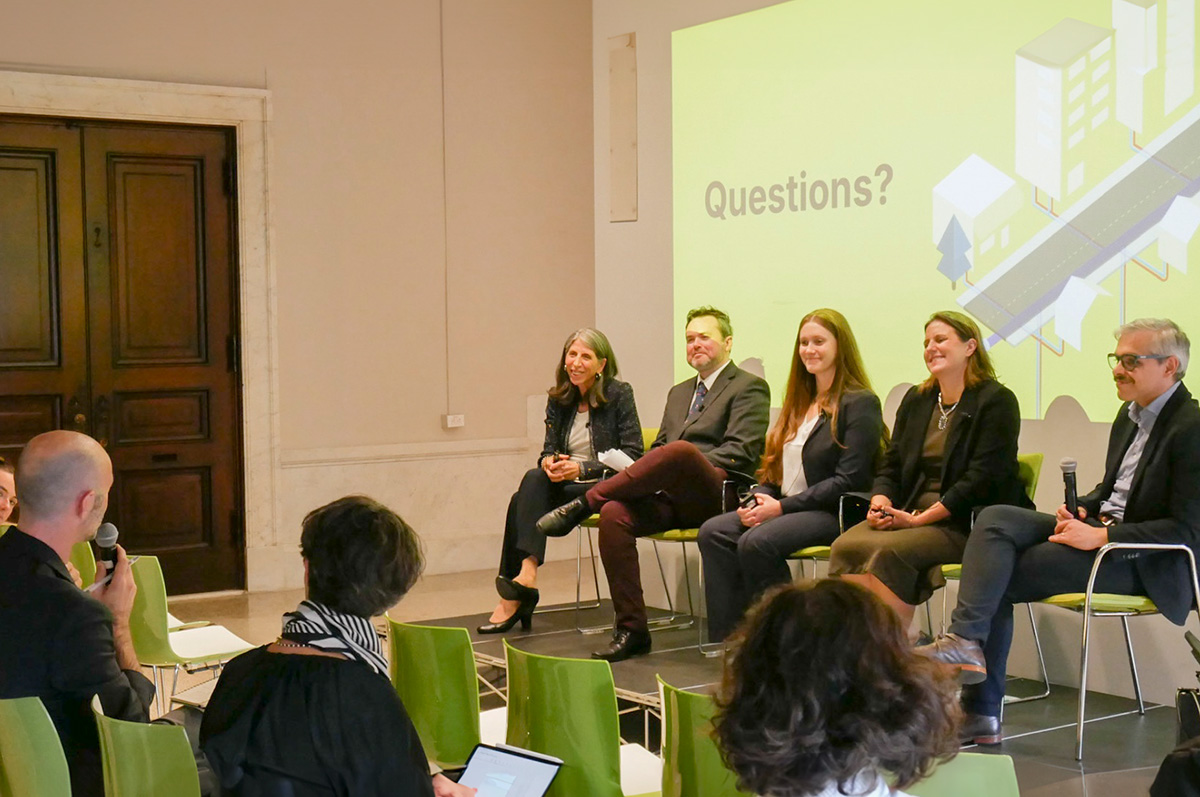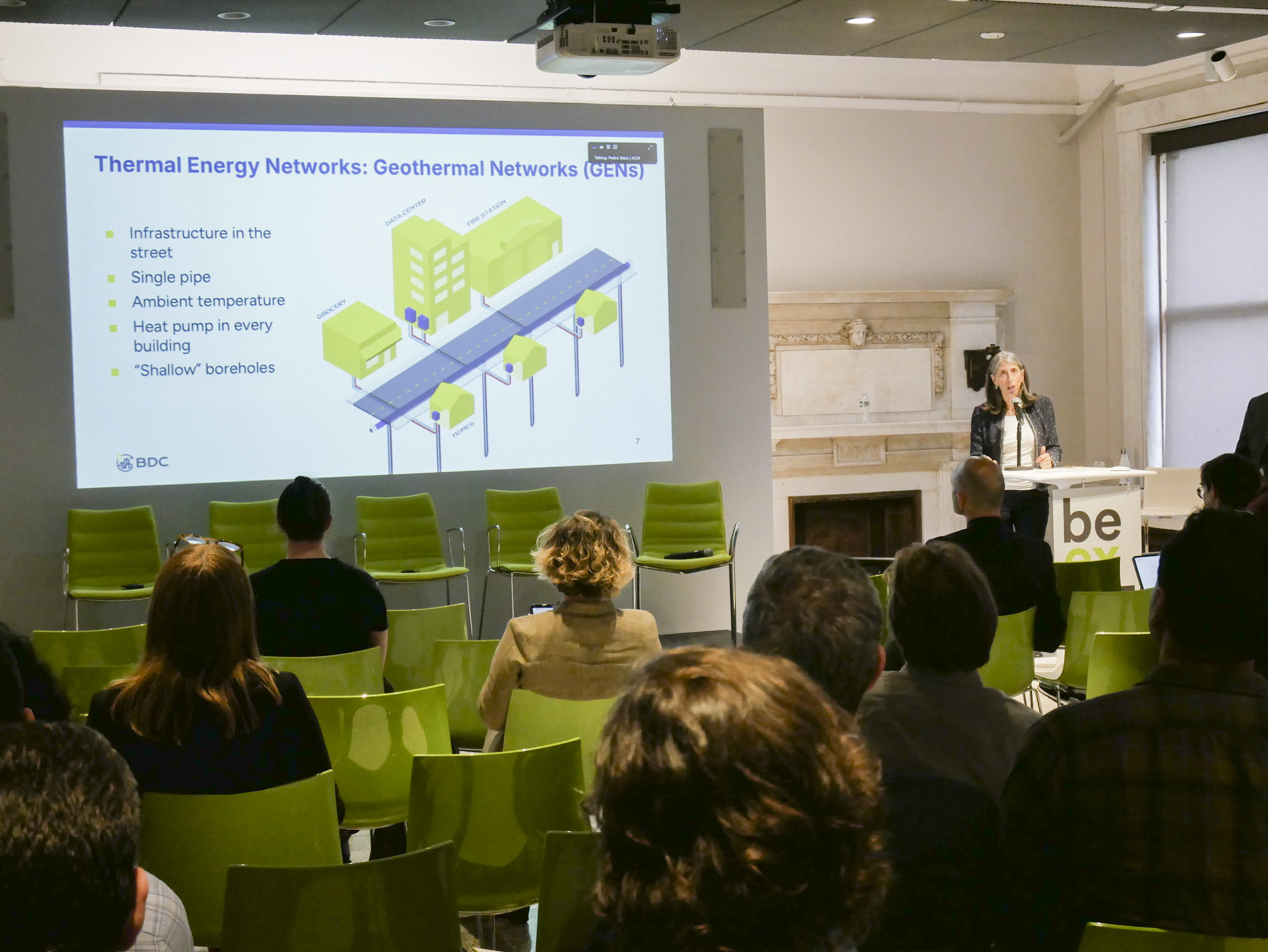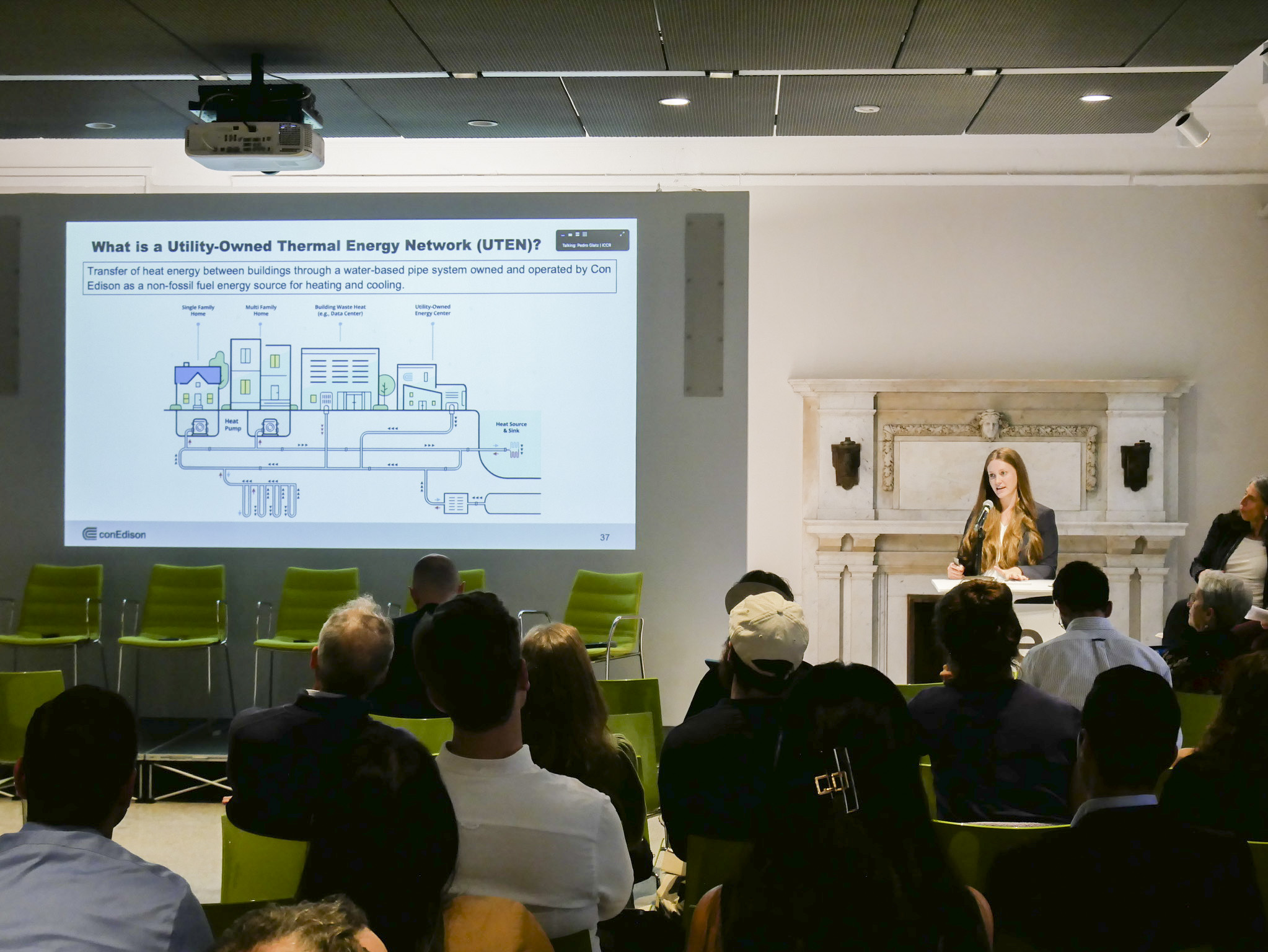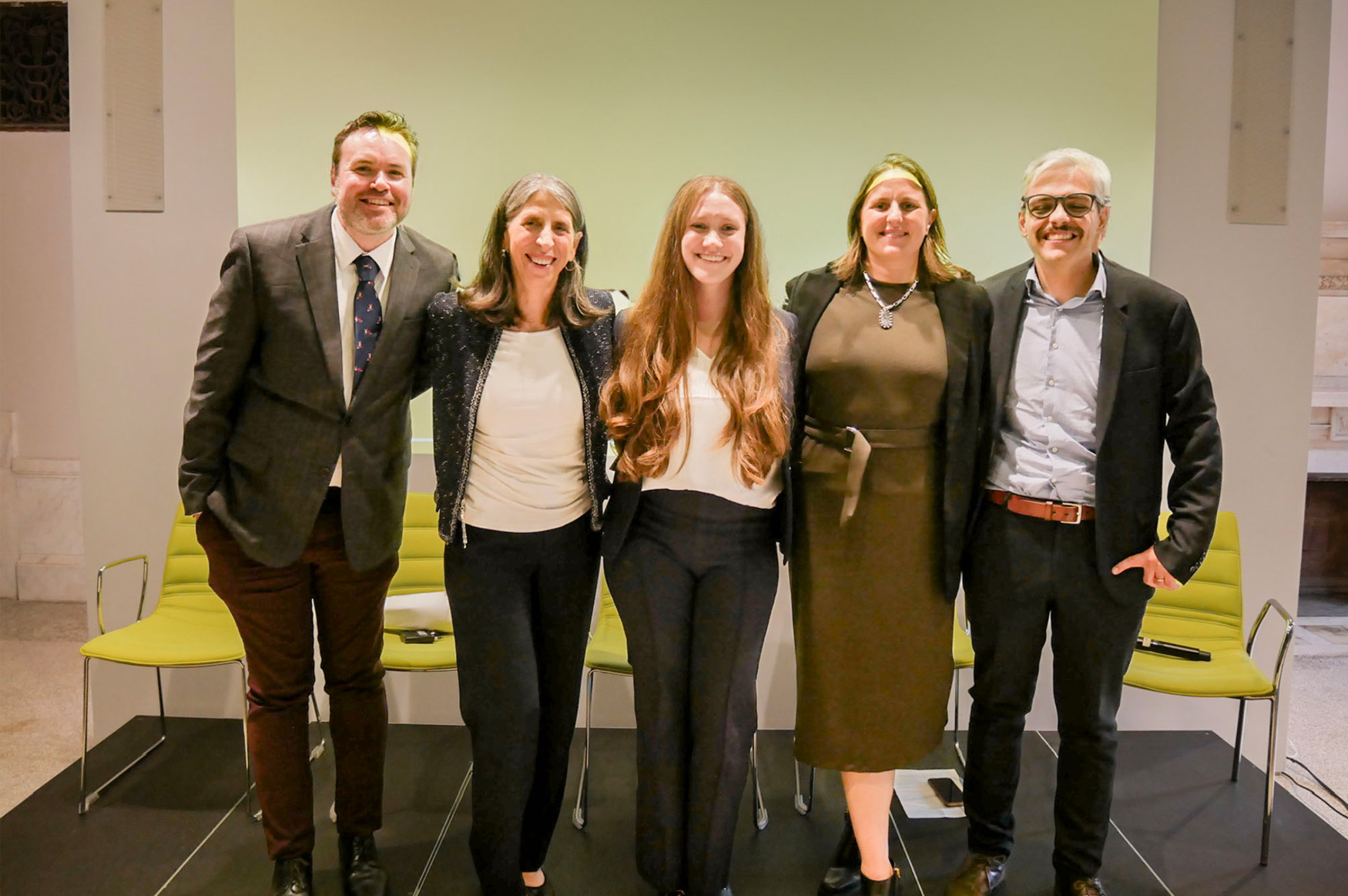
“Thermal energy networks are good for local jobs and local economies, and I’m going to tell you why.” — Mike Roles, Climate Jobs Rhode Island
Thermal energy networks (TENs) are proven climate-friendly heating and cooling solutions. At Climate Week NYC, over 160 panel attendees learned why they are also an investment-worthy strategy for a just energy transition.
The panel, “Thermal Energy Networks: Invest in the Future of Heat,” was co-hosted by the Interfaith Center on Corporate Responsibility (ICCR) and the Building Decarbonization Coalition (BDC). It featured speakers from the BDC, ICCR, New York-based gas and electric utility Con Edison, labor & advocacy coalition Climate Jobs Rhode Island, and investment firm Boston Common Asset Management.
These perspectives illuminated TENs as more than just a clean energy technology. When guided by the principles of a just energy transition, TENs can be a catalyst for social and environmental change, sparking fruitful collaborations across and between labor unions, advocates, investors, and businesses.
Here are highlights from each speaker.
Remarks have been condensed and edited for length and clarity. You can watch the full recording here.
“Sustainable corporations must look beyond the next earnings report to account for the full impact of their businesses on society.”
Christina Herman, Interfaith Center on Corporate Responsibility
ICCR is a coalition of some 300 faith- and values-based, long-term institutional investors; asset owners and managers representing over $4 trillion in assets under management or advisement. We view shareholder engagement with corporations as a powerful catalyst for change. Our statement, “inspired by faith, committed to action” sets forth our pledge to be active owners, and to engage meaningfully with the companies in our portfolios through the process of shareholder engagement that we pioneered more than 50 years ago.
Our guiding principle as shareholders is that sustainable corporations must look beyond the next earnings report to account for the full impact of their businesses on society and must view the well-being of all their stakeholders―including their workers and the communities where they operate—as integral to their long-term value.
Deeply concerned about the climate crisis, and the potential costs to society and to investor portfolios from a failure to decarbonize our economy, quickly and equitably, ICCR members have been actively engaging the energy utility sector on the need for a just transition for many years. We understand that we cannot continue to burn fossil fuels to heat and cool our buildings, which has led us to explore alternatives.
Thermal energy networks can help not only by reducing greenhouse gas emissions, but also by improving grid reliability as demand increases for electricity. ICCR has been interested in the potential offered by thermal energy systems for several years now, and we are delighted to see the momentum for adoption of geothermal and other thermal energy systems by energy utilities.

“When you transition a whole neighborhood at a time, you get incredible systemic benefits.”
Ania Camargo Cortes, Building Decarbonization Coalition
“Why should gas utilities do this?” is a question I often get.
Imagine a neighborhood that is hooked up to the gas system. People are incentivized to transition from gas to electric heat pumps, so they start doing that. As homes electrify, there are fewer and fewer customers paying for the entire fixed cost of the gas system. The cost of gas goes up. In the end, the only people left with gas are the ones who couldn’t afford to transition to electric, or who don’t have the power to transition to electric, like renters.
This is an enormous equity issue. A study commissioned by gas utilities in Massachusetts found that decarbonizing building-by-building results in the worst energy burden on ratepayers, but transitioning gas to geothermal at neighborhood-scale has the lowest energy burden.
At the Building Decarbonization Coalition, we advocate for decarbonizing whole neighborhoods at a time—including renters and owners, high- and low-income people. When you transition a whole neighborhood at a time, you get incredible systemic benefits.
If we electrified every building but did nothing with the gas system, we’d still have millions of miles of gas pipe under our streets leaking methane, a very powerful greenhouse gas. We must think about how we are going to transition and decommission these gas pipes. And gas utilities are the ones with the ability and expertise to do this.
Then there are the major cost implications. Utilities are planning to replace methane gas pipes at an enormous cost to ratepayers. Nationally, it’s projected to cost about $740 billion over the next 15 years. Wouldn’t it be so much better to replace our gas pipe with a water-filled pipe? Instead of investing in gas pipes that could become stranded assets, gas utilities should invest in the clean energy future that we’re asking for.
“Thermal energy networks represent our biggest hope to ensure that workers are not displaced.”
Mike Roles, Climate Jobs Rhode Island
I’m the Executive Director of Climate Jobs Rhode Island, a coalition of 30 environmental organizations, labor unions, and community organizations. Our work starts with solutions developed by frontline communities and frontline workers. So when we’re looking at policy solutions, we’re asking: does it meet Rhode Island’s Act on Climate goals to the scale that science demands? Does it invest in local economies, and does it create the sort of community-based wealth through good jobs that it needs to? And thermal energy networks frankly do.
There are some challenges and risks to decarbonizing the economy. There is a risk of displacing really good, family-sustaining careers. There are a lot of gig-economy businesses taking advantage of the net-zero economy. They pay substandard wages—in some cases poverty wages—and may misclassify workers. Some people are even facing instances of wage theft. We need to avoid this to the best of our ability. We need to build this economy from the bottom up and middle out.
Thermal energy networks provide the scale we need, not only for consumers but also for workers. We have utility workers within the gas system who construct and maintain pipes who will be able to transfer skills to thermal energy networks, allowing them to continue their work and maintain a roof over their heads.
So why unions? Working with unions is good for business and good for the economy. Unions give important voice and power to workers, but also set the gold standard for safety, skills training, and certification. Unions have the apprenticeship and pre-apprenticeship programs that we need at the scale necessary to implement new technologies. Unions respond to policy and market signals, so as thermal energy networks scale, apprenticeship classes grow, and more individuals—particularly those from the front lines, and those experiencing poverty—will have the opportunity to enter these programs.
Thermal energy networks represent our biggest hope to ensure that workers are not displaced and don’t lose good-paying careers. As we say in the union movement, we can have our bread and roses too.

“A priority is protecting customers.”
Brittni Provencher, Con Edison
I’m here today because of the Utility Thermal Energy Networks and Jobs Act (UTENJA) that New York passed into law in 2022. This law gave the state another tool to help achieve its aggressive decarbonization goals by 2050. It requires New York’s seven biggest utilities to propose at least one thermal energy pilot project to our regulators, the Public Service Commission of New York.
Con Edison purposely picked our three pilot projects to generate the most learning we possibly can for the state. We have different customer types, different building types, and different thermal energy sources.
Our first pilot is proposed in Mount Vernon, a disadvantaged community in Westchester County. This involves two district geothermal loops and three borefields with over 100 boreholes. The loops will connect residences, churches, a fire station, a medical office and a recreation center. We will have a BTU meter for each customer to measure the thermal energy put into or taken out of our utility thermal energy network (UTEN). A priority is protecting customers and disadvantaged communities, so we’re going to have bill caps to prevent customers from paying more than they currently do for HVAC.
Next is our pilot in Chelsea, Manhattan, also in a disadvantaged community. The thermal energy resource will be a data center and commercial office building at 85 Tenth Avenue; we will extract heat from that large building’s chilled water plant and put it in our UTEN. It will provide domestic hot water to four New York City Housing Authority buildings, plus heating and cooling to one of those buildings. We’re excited about this because it’s a great area for thermal energy sources other than geothermal. Data centers provide a constant source of reliable heat year-round; we can capture that heat and utilize it in our systems, providing warmth to customers connected to the network.
Our final project is located at Rockefeller Center. In this initiative, we will extract waste heat from Tishman Speyer’s Central Plant chilled water system, which will be integrated into our UTEN. The UTEN will provide heating, and possibly domestic hot water, to two buildings owned by Tishman Speyer and one additional building across Sixth Avenue owned by Rockefeller Group. A unique aspect of this is the intention to develop a future marketplace to facilitate the exchange of waste heat among buildings. This would allow those buildings to contribute waste heat to the UTEN, and Con Edison would compensate them for this contribution, creating an efficient and sustainable heating network.
Lawmakers placed emphasis on job creation and job security for the natural gas transition. We are still pretty far away from construction—we don’t know which projects will be approved for construction yet—but Con Edison is in early talks with the New York State Building and Construction Trades Council to facilitate project labor agreements and utilize a union workforce for skilled labor during construction.
“Our voice is important as investors, and more important than our voice—especially with regulated utilities—is the voice of the stakeholders who will be impacted.”
Amy Orr, Boston Common Asset Management
Boston Common is a boutique asset manager founded over two decades ago. We invest at the intersection between social change and financial return; we don’t believe you have to give up one to get the other.
We invest in the utilities sector and believe utility companies play an incredibly important role in addressing the need for decarbonization in our buildings. If we care about reducing emissions and ensuring a sustainable future, utilities are an instrumental part of this puzzle.
Active ownership is core to our firm’s strategy. We believe our voice is important as investors, and more important than our voice—especially with regulated utilities—is the voice of the stakeholders who will be impacted. At the end of the day, ratepayers drive the revenues for these companies.
It’s essential to also consider the concerns of stranded assets in our investment strategies. Investing in aging infrastructure is not a smart decision. Why don’t we consider technologies that could replace that infrastructure rather than investing in something that will soon become obsolete?
So, why thermal energy networks? At Boston Common, we focus on circularity. We find Con Edison’s Chelsea pilot and the potential of tapping into the heat of data centers interesting. We also consider the toll that increased electrical transmission infrastructure will have on nature and ecosystems. Thermal energy networks are compelling because they reduce the need to build transmission lines that risk further depleting natural ecosystems. Take solar, which has a significant impact on resources and extraction in other countries. There is no need to extract natural resources from other countries to power thermal energy technology.
We are further interested in is the hyper-local nature of thermal energy networks. We’ve seen negative examples of utilities bringing substations to disadvantaged communities with great intentions, but the benefit of that substation is mostly felt elsewhere. This is not true with thermal energy networks; community members can be involved in the projects and see the benefits of the buildout in their own backyards – and directly in the form of cost savings in their utility bills.
Finally, we think about workforce. Going the non-union route can backfire on companies through higher turnover, injury rates, and class action lawsuits. We do everything we can to help utilities see that the race to the bottom that a gig workforce fosters is not a smart or sustainable path forward.
Good governance and strong stakeholder feedback loops underpin everything for us. For utilities, those are more important than ever because communities and workers are ratepayers, and they’ll have a meaningful impact on a utility’s ability to sustain itself. Thermal energy networks show interesting potential. As investors, we want to see more evidence of its potential through these pilot projects.

“For all of us in this space, we see thermal energy networks as an essential part of a just transition. And when we talk about a just transition, it is a tough path and process. That’s why we need to have these conversations. Talking about specific details of policy, of projects, of investments are the type of conversations we want to create here.”
Pedro Glatz, ICCR

